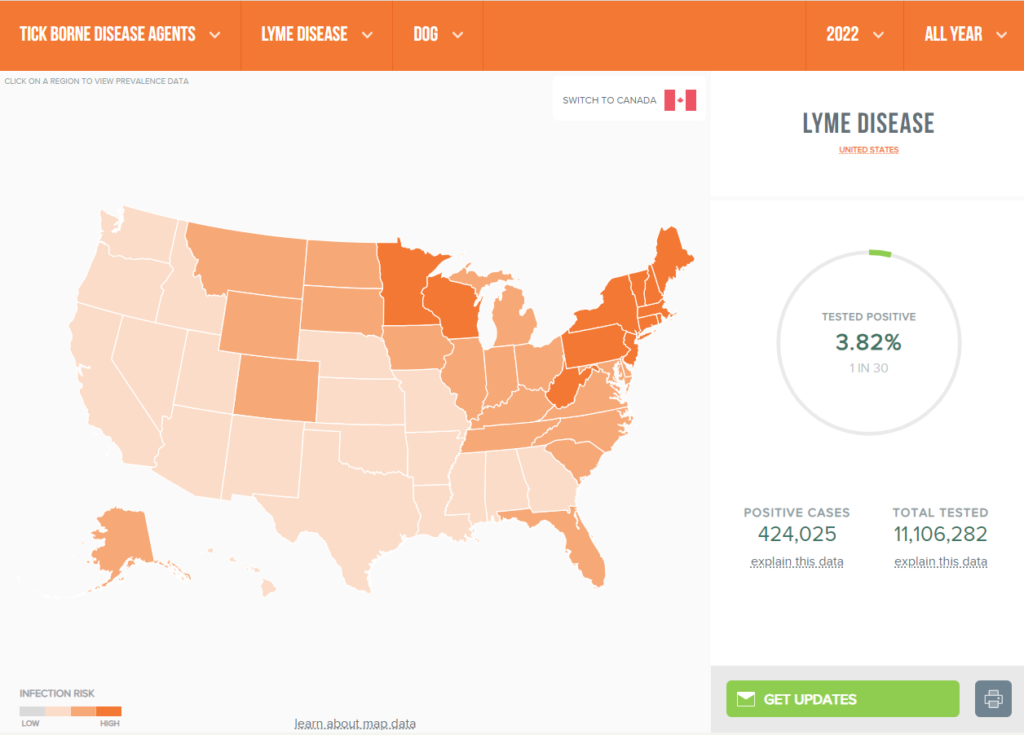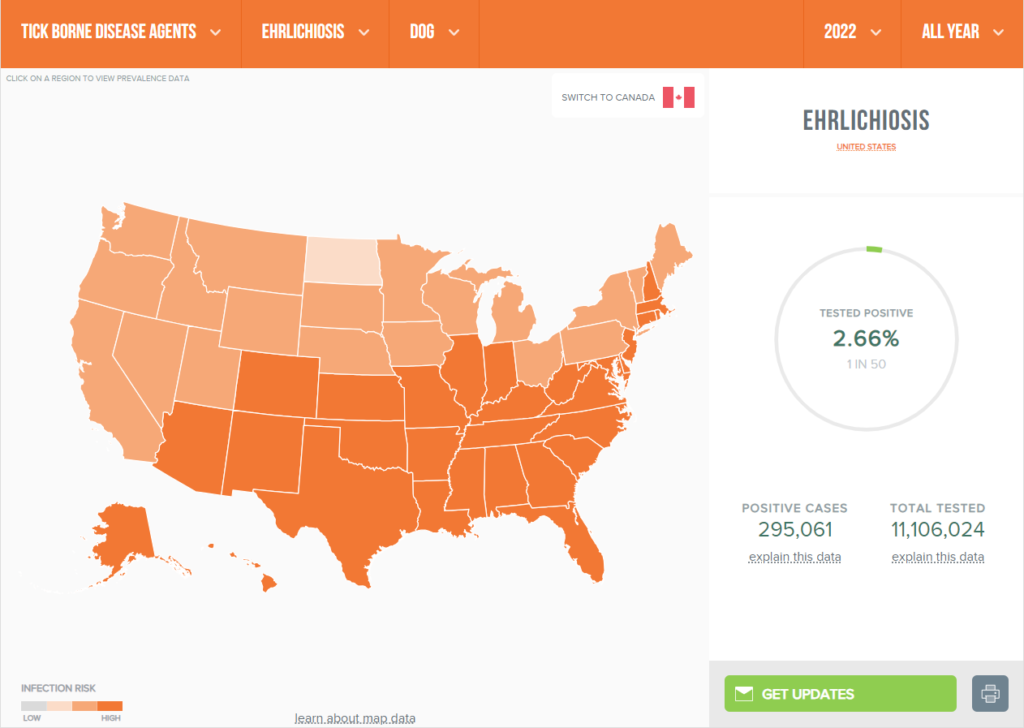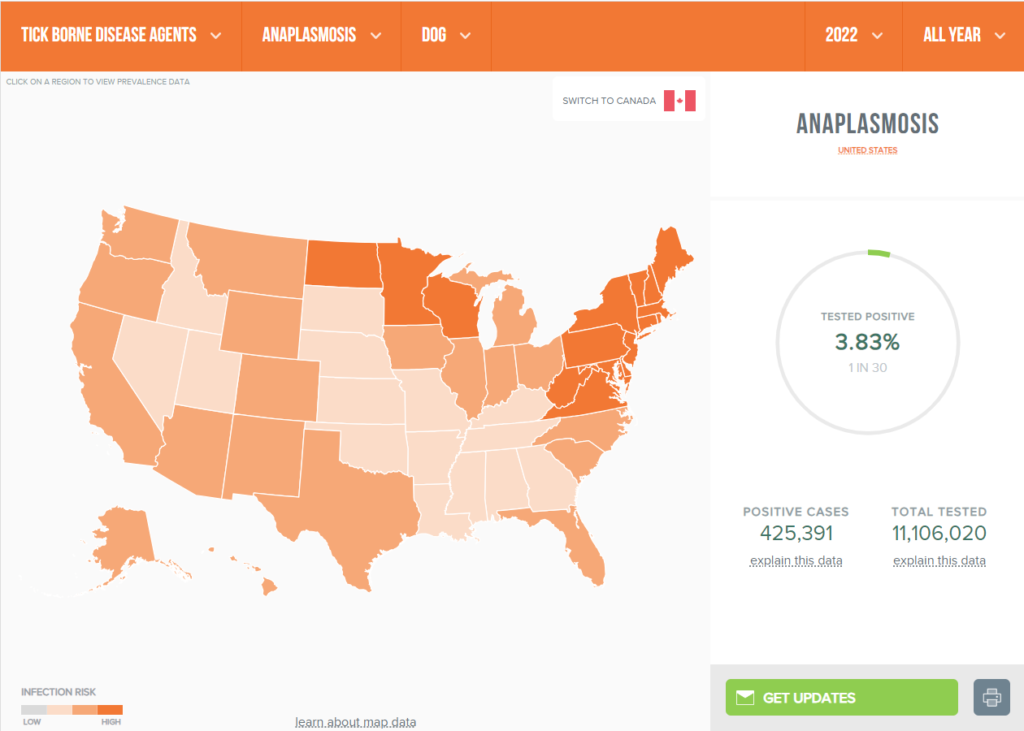During this season we love to go out walking in the woods or wandering off the beaten path to enjoy the fall colors. The temperatures are perfect for our pets to enjoy the great outdoors. The challenge is the threat for us and our pets when it comes to tick borne diseases. We all think of ticks and fleas in the spring -summer seasons but the deer tick have a very active fall cycle as well. In May 2017 I wrote a blog called “Spring has Come”. The main focus was on the tick borne diseases of Lyme, Erlichiosis, and Anaplasmosis. These are the 3 main tick diseases we currently see in our canine patients in this area. If interested in reading more about those diseases, please follow this link to my previous blog.
As I stated in the blog 5 years ago, year-round prevention for fleas and ticks is needed. Our climate changes are creating a perfect opportunity for deer ticks to spread disease in all seasons. January and February of 2023 we had many days with no snow on the ground. Now don’t get me wrong, I am happy when there is no snow, but the deer ticks are even more excited about that. They will continue to be active and searching out hosts to continue their life cycle. I spoke with a taxidermist who indicated he must leave the deer in his freezer for 1 month before the ticks will be killed. Do you know of any other living creature that could sustain 30 days in a freezer?
In 2023 checking our client’s dogs for tick borne diseases, we have had 10 positive cases. That is 10 more than last year. This tells me we need to do a better job of tick prevention. These 10 cases were dogs of all sizes and some live within the city limits. If you live in Madison County, ticks are everywhere all year-round. Do not be fooled into thinking the weather has changed and we no longer need to do flea/tick prevention. WE DO NEED TO PROTECT OUR FURRY FRIENDS FROM THESE TICK BORNE DISEASES. The following images show the 3 common infections in our country. It is obvious that we are not in the heaviest infected regions but we are not far behind. Please protect each and every pet!
I am often surprised by people who move to Iowa and are not familiar with the tick-borne diseases. They have been made to believe that these tick diseases are no risk for their pets if living in Arizona or Montana for instance. I look at these maps and disagree totally with those statements. With people traveling across our great nation with their canines we are going to see these diseases on the rise in all areas of the country. Here in Iowa ticks have always been a threat to our dogs. In the last decade we have been fortunate to have new products that work better than the topicals of the past. These new oral products cover from their nose to their tail. No more sticky substances on their skin. No more issues with bathing or swimming. No more issues with grooming or thick hair coats that make it difficult to get the product to the skin. No more skin reactions from the topical products. A new generation of products that really can protect our furry friends.
My favorite product is Bravecto for flea and tick prevention. It is a 12 week chewable or dermally absorbed topical, if your pet is finicky, that goes internally. It has been on the market close to 10 years with minimal side effects. Over 250,000 million doses have been sold worldwide in 90 countries. Bravecto starts killing fleas previously on dogs within 2 hours and ticks within 4 hours. If a dog has Bravecto already in place ticks rarely attach and if attached quickly dry up. A flea will only bite once before dying which is great for flea allergic dogs who have major skin reactions each time the flea bites them. The chewable product must be given with a meal of food to help break it down to assure proper absorption for the 12 weeks. The topical product is applied to the skin and dermally absorbs. Once dry it can be removed through bathing and combing. The dog product is available in both forms, but the cat product is only topical. I think they knew cats will not typically eat something new when it is presented to them.
The side effects of this new class of preventions, in the isoxazoline family, are few. Reports of seizure like activity are seen in 1 out of 10,000 dogs. Now don’t get me wrong- when that is your dog– you are worried. I had one of those dogs. I verified it with 2 doses of bravecto 3 months apart. Within 10-14 days after the dosage was given I saw a seizure. I then returned to a monthly topical. He was fine from that point forward. The seizures will not continue if you stop the product. I was disappointed I could not use the oral Bravecto since it has been such a great preventative for Winterset Veterinary Center for the last many years. My cats are on Bravecto and I love the 3 month duration. This makes it much easier to not miss a dose. We are all busy so the less we have to remember each month the better.
A close second to the Bravecto, is another isooxazoline product called Simparica Trio. It contains a heartworm and intestinal parasite prevention along with the flea and tick aspect of it. It must be given each month but is extremely successful preventing these tick borne diseases as well. It also is in a chewable format that dogs love.
I do not care what flea/tick prevention you use but please do it year-round in Madison County Iowa. If you find ticks on your dogs or cats that are attached and feeding, they are at risk for these tick-borne diseases. Once they are infected, they never clear the infection from their bodies. There are many other products besides those I have named here. Ask your veterinarian how to prevent tick borne diseases in your area. If we can stop the ticks from feeding on our pet’s we will stop the threat of tick-borne diseases in our furry friends as well. Do your part and start year-round flea and tick prevention. Enjoy the fall weather and beautiful colors.




